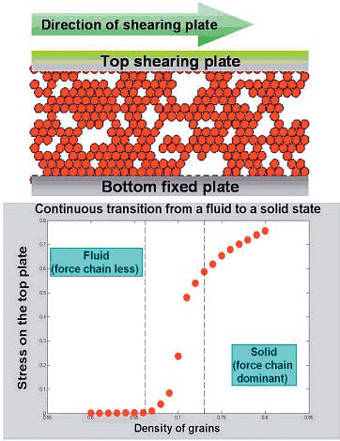At the turn of the 19th Century, Osborne
Reynolds observed granular dilatancy. While walking on wet sand it appeared to dry out briefly beneath his feet. In fact the sand was expanding under the pressure exerted by his feet! Granular materials are everywhere, such as sand and rocks, in the raw constituents of industry where they are the second most utilised matter after water, and even in space, where asteroid fields are granular material on a large-scale.
We are involved in the study of granular dynamics, in particular the so-called solid-fluid phase transition. Currently we are studying confined granular material subject to shear (see figure) and we have developed a computer model for this purpose. The model employed is unusual in that it is extensively based upon Boolean logic where the collisions and motion of the granular particles are described in terms of truths and falsehoods. Particles either exist at a point in space or they don't, they move or are stationary. The practical advantage here is one of speed, but a deeper consequence emerges.
 (Top) The sheared granular medium showing a sample force chain network in red. (Bottom) The continuous fluid to solid stress transition.
Images of the force chain network, as shown above, have been generated from the model and used to study the evolution of the network during shear. A smooth or continuous transition from a force chain-less (fluid) to a force chain dominant (solid) state is observed as the density of grains being sheared increases beyond a critical value. A similar transition is observed in real experiments on sheared granular materials, and it is remarkable that the simple model used here recovers the detail of these experimental observations, particularly since the model includes only a very limited and incomplete description of force. The conclusion is that the transition in both the experiment and the model transcends the exact details of the system. Such universal behaviour may lead to understanding other sheared systems, such as tectonic plates, where the effect of shearing leads to potentially devastating earthquakes.
(Top) The sheared granular medium showing a sample force chain network in red. (Bottom) The continuous fluid to solid stress transition.
Images of the force chain network, as shown above, have been generated from the model and used to study the evolution of the network during shear. A smooth or continuous transition from a force chain-less (fluid) to a force chain dominant (solid) state is observed as the density of grains being sheared increases beyond a critical value. A similar transition is observed in real experiments on sheared granular materials, and it is remarkable that the simple model used here recovers the detail of these experimental observations, particularly since the model includes only a very limited and incomplete description of force. The conclusion is that the transition in both the experiment and the model transcends the exact details of the system. Such universal behaviour may lead to understanding other sheared systems, such as tectonic plates, where the effect of shearing leads to potentially devastating earthquakes.
Contact: Barry Fitzgerald or
Dr. David Corcoran,
Nonequilibrium Dynamics Group, Department of Physics,
University of Limerick;
E-mail:
[email protected];
[email protected].
|

